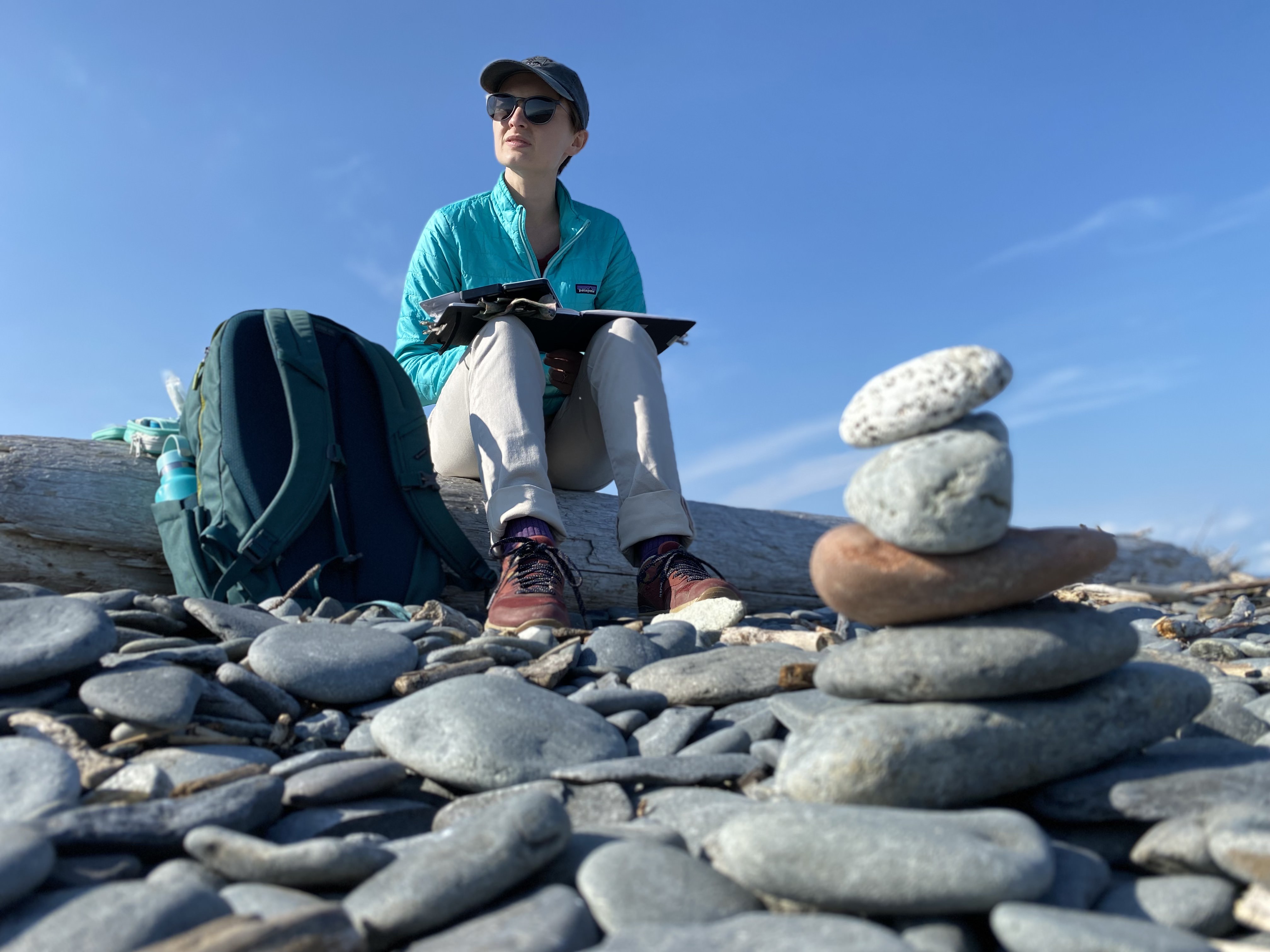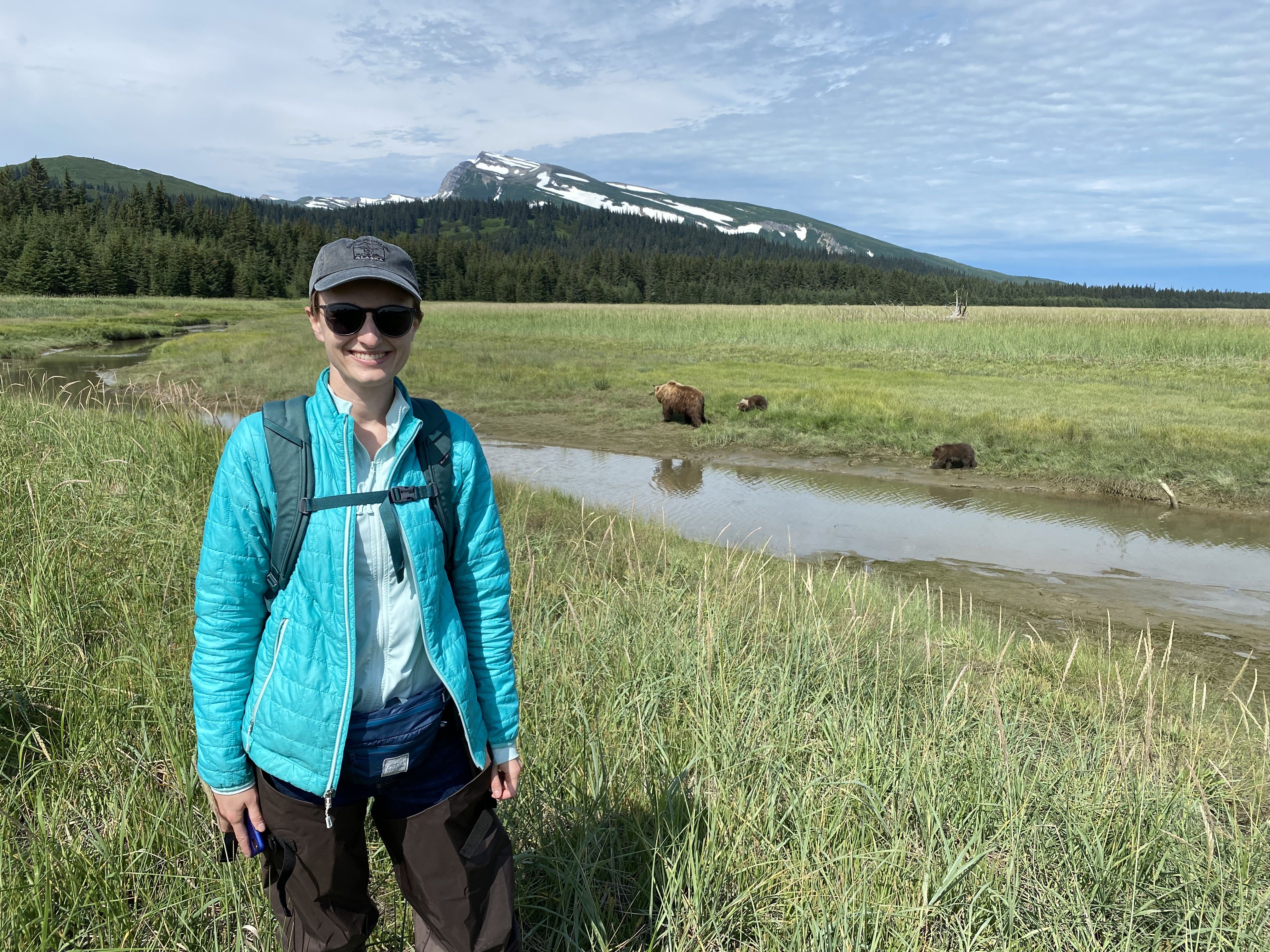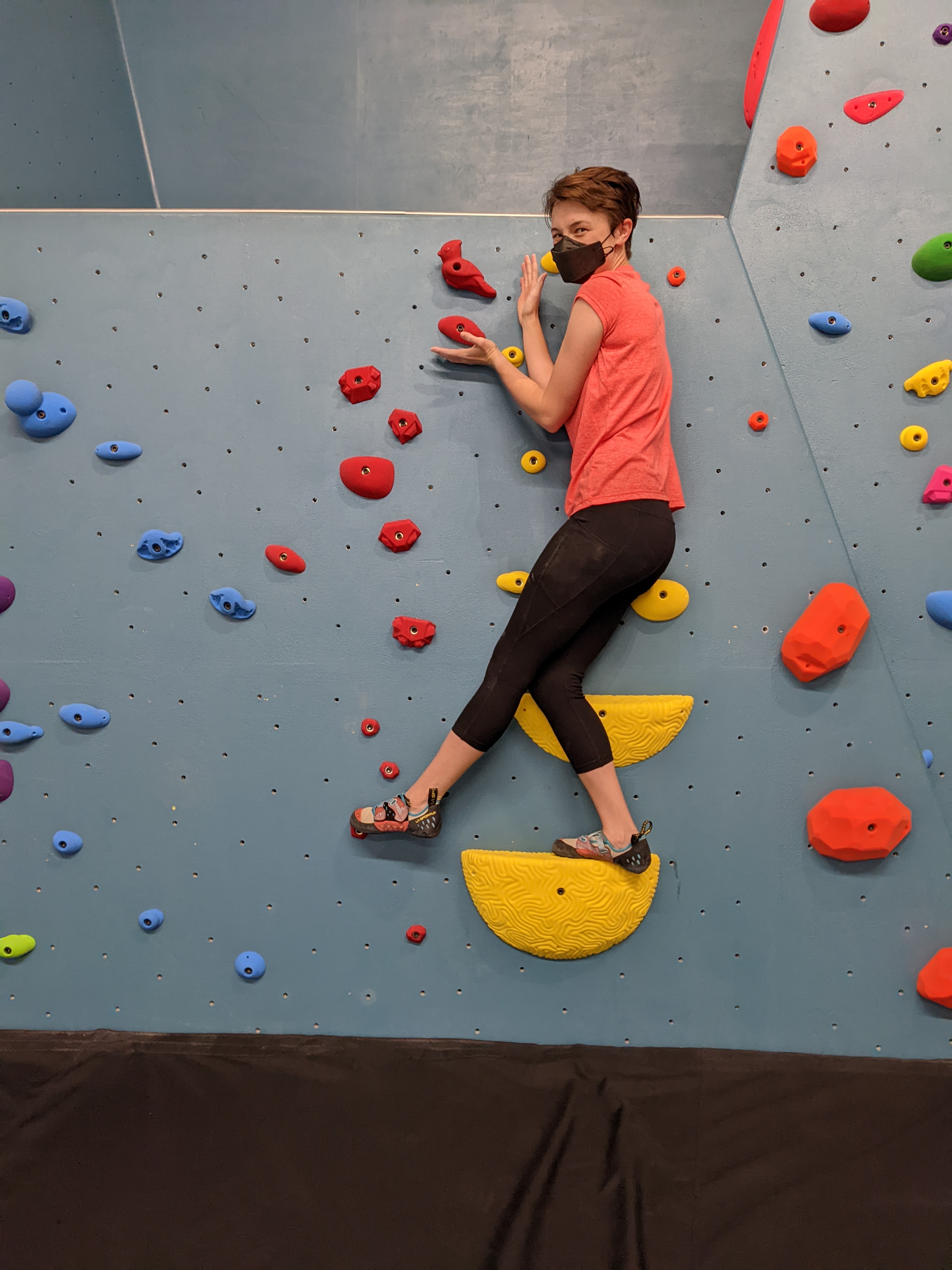
Admiring a cardinal-shaped hold in the kids’ area | Image taken by Lucy
My Climbing Journey
I’ve always loved climbing things. As a kid, I would climb trees in the yard and read a book in their branches. At some point, I must have gone indoor rock climbing for a birthday party and convinced my parents to build a traversing climbing wall on the back of the house. I spent hours spidering my way back and forth across this wall. Later, my high school installed a rock climbing wall and I spent clubs period there, climbing the top-rope routes.
Yet for some reason, this love for climbing never developed into a dedicated sport. I played plenty of other sports growing up - softball, soccer, volleyball, cross country running - but never ended up climbing in any structured or competitive fashion. My guess is that there were more logistical challenges compared to joining a school-based team sports league and it would have limited my ability to simultaneously participate in robotics, theater, choir, and the school radio show.
I then went to college and forgot about climbing until moving to Austin post-graduation in 2015. Austin Bouldering Project (ABP) had just opened up its first location in town. It is a gym entirely devoted to bouldering (explained below in more detail), which I find the most fun type of climbing. I quickly bought a ten-visit punch pass and visited once every few weeks. However, I felt limited by the day passes. If I visited the gym - at that time a 20-minute drive from home - and only had energy to climb for 45 minutes, I’d feel like the visit was a waste of money. So, I saved up my punch passes until I knew I could spend a decent amount of time at the gym and hopefully tack on one of the included yoga classes to get the most bang for my buck. This meant that I typically climbed too hard since I would go well past a regular level of fatigue.
As one might imagine, this was not a constructive way to get good at a hobby. I felt so restricted by the time and financial investment that I stopped visiting the gym on my own and focused on other hobbies. I only climbed if I was going with a friend for a multi-hour visit. I started this travel blog and spent time exploring the world, then everything shut down due to the pandemic. Would I ever climb again?
The answer is most definitely yes. As I’ve mentioned in my post A New Unplan-It Earth, I am currently on sabbatical from the working world and have been taking the time to develop myself. I have plenty of time during the week to climb without it being my only extracurricular. I joked about not wanting it to become my defining character trait, but as my friends can attest, I haven’t stopped talking about climbing since I started going regularly in mid-December. As even more of a reduction in barrier to entry, ABP opened up a new location a mere eight-minute drive from home and next to our regularly frequented grocery store.
I finally have the time, energy, and motivation to join the gym as a full-time member. It’s just as thrilling and addicting as I remembered from before the pandemic. I’m making friends and even have a few regular climbing buddies. I’m improving and can feel my body growing so much stronger even after only six weeks of climbing.
The interior of Austin Bouldering Project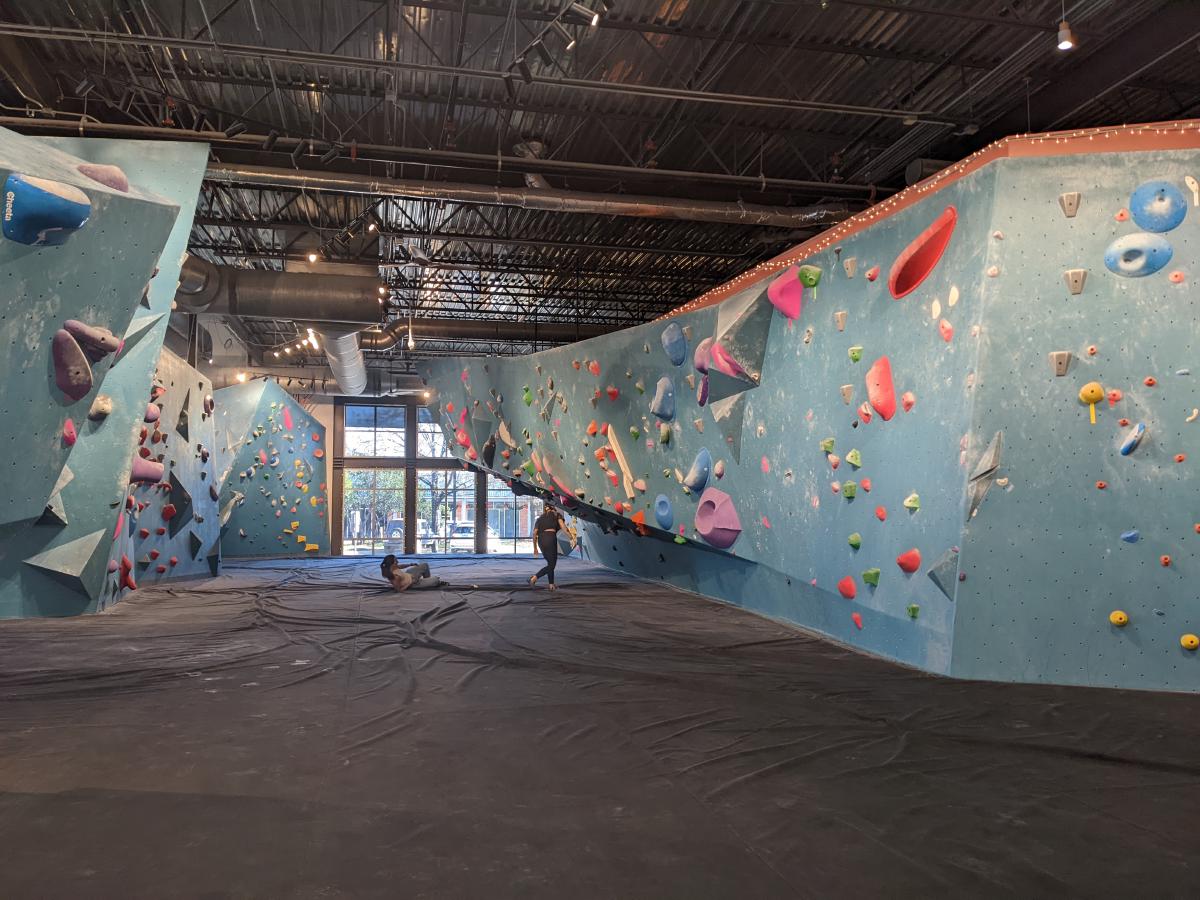
Interlude: What Is Bouldering?
Bouldering is climbing on rock formations or walls without the aid of ropes or harnesses. Essentially, you climb under your own power, and if you fall, you fall to the ground (or a very thickly padded floor). In an indoor setting, holds are made of molded plastic and bolted to a wall constructed out of plywood with a textured surface. In a gym, the walls reach a maximum height of 18 feet, but outdoors a boulder can be as tall as you feel comfortable climbing (or falling onto a crash mat). Don’t worry, I learned how to fall correctly and safely and the mat is very thick! My worst injuries so far are a few scraped knuckles and elbows.
There are three main types of climbs: slabs, vertical faces, and overhangs. Each of these requires different strengths and techniques. Slab is where the wall is angled slightly less than vertical, so they require balance and technique to ascend without slipping off and scraping down the surface. Vertical faces are standard climbs where the wall is vertical and require good footwork to push yourself up the wall instead of using your arms and tiring yourself out. Overhangs are typically the most challenging for beginners, as they are angled more than 90 degrees and sometimes are completely horizontal, requiring upper body strength and strong core to stay on the wall.
The green slab problem I’ve been working on for the past week An example of an overhang area (note the 45 degree angle) with the green problem I was projecting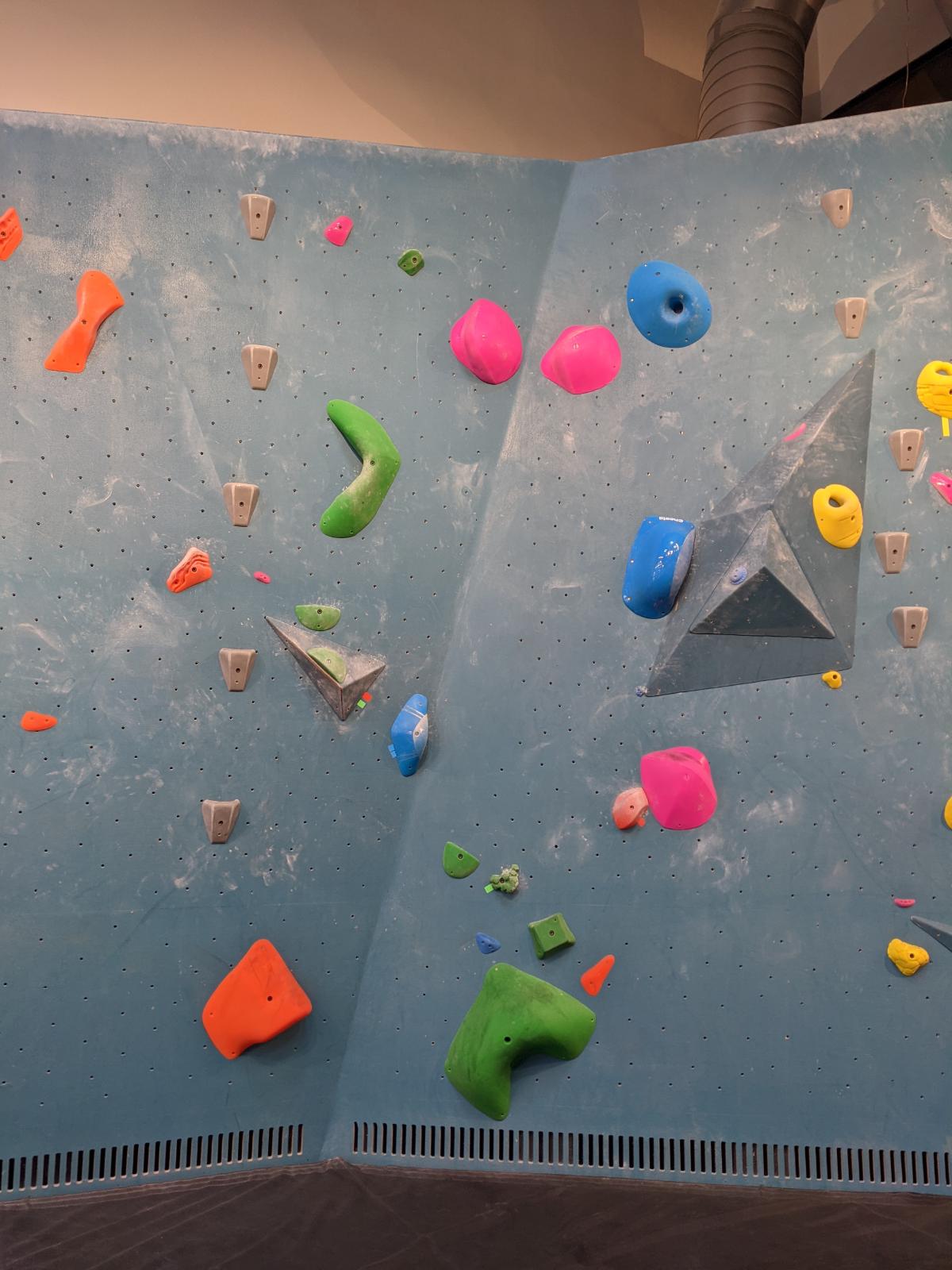
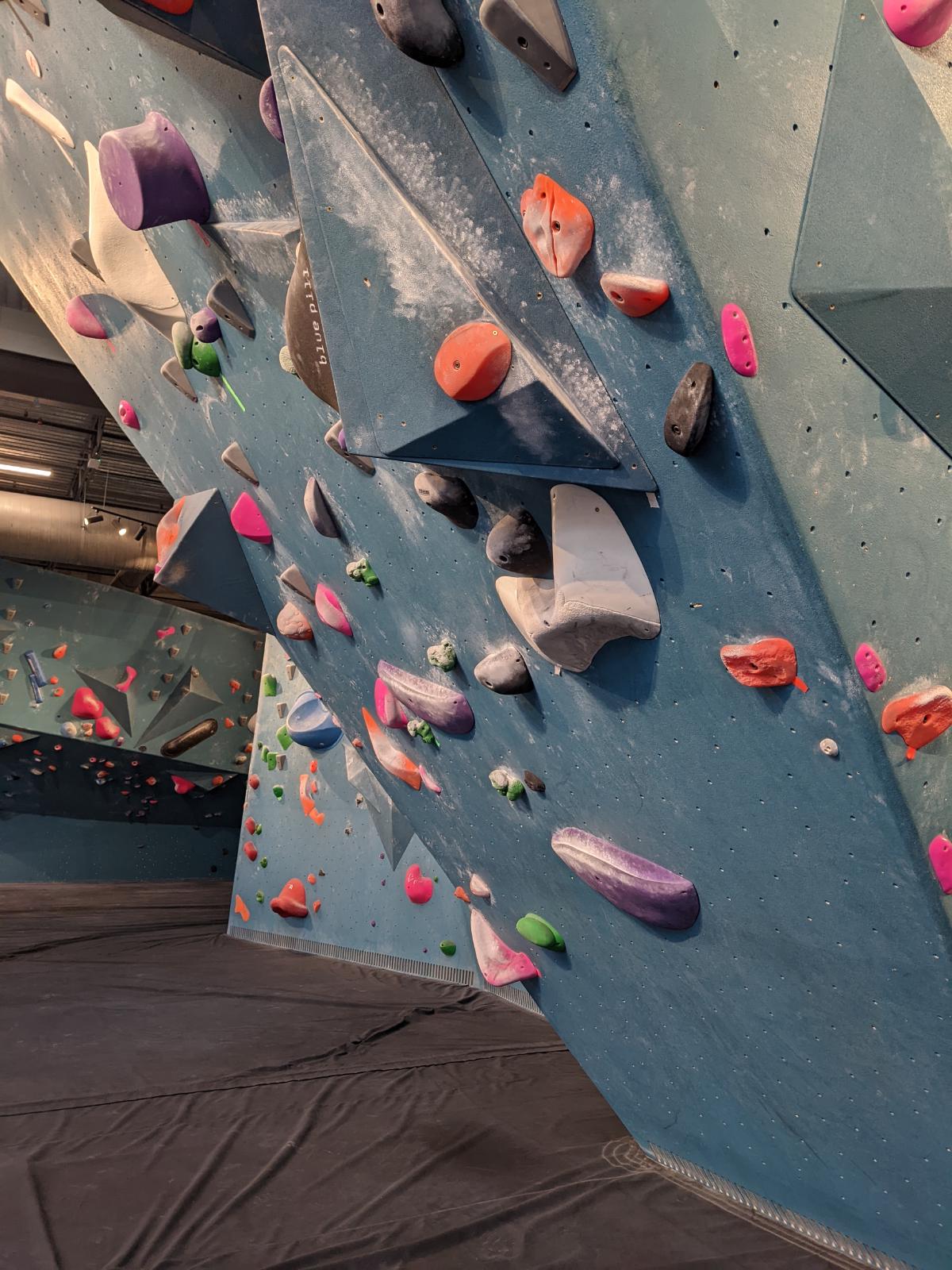
Right now, I enjoy slab climbing the most since I’ve found success with balancing and technique as I build up my strength and endurance for overhangs and vertical walls. While I’ve been able to climb some higher-rated slabs, I’m challenging myself to try all three types of climbs to become a well-rounded boulderer.
In my gym, the difficulty of the bouldering problems (a set of holds with a start and end point) is color-coded, with green being the beginning of the intermediate climbs. Other gyms and outdoor problems typically use the V-scale, but ABP uses colors, which I find less intimidating and makes me more willing to try projects outside of my comfort zone. I can currently climb all of the greens in my gym and a few of the next level, purples. The grading is fairly arbitrary, and what may be easy for one climber could be very challenging for someone else even at a similar level. The important thing is to try hard and have fun challenging myself.
Thoughts About Bouldering
I currently climb three times per week. I wish I could go more often, but I need to take rest days to recover in order to avoid injury and to have enough strength for climbing days. Climbing uses muscles and tendons that are rarely used in everyday life and can be very taxing on the body. Funnily enough, we don’t tend to hang from our fingers that often during the day. I’m always so excited to get back to the gym and work on a problem (a process called projecting) that I had been trying for a few sessions. It’s such a rush to finish a problem that just a week ago I couldn’t even imagine being able to do. Now, I can run circles around it and use it to practice technique and form.
Bouldering is special in that it can be a solitary activity or very social depending on how I’m feeling. On a day when I am feeling more self-conscious or just want to practice by myself, I can go to the gym and climb alone. If I feel like being social that day, I can meet a friend who provides encouragement and suggestions for problems I’m stuck on.
My buddy has really pushed me to reach my potential. Towards the end of a recent session, I was tired and figured I didn’t have a chance at “sending” (finishing) a green slab with a move I’d been struggling with. My partner said, “Okay, well why don’t you just try the first move to see if you can get it, or at least practice for next session?” I was doubtful, but amazingly I stuck the move and finished the climb. I never would have done that if she hadn’t been there to push me.
Sending the Green Slab (with a fancy animation!) | Images taken by Lucy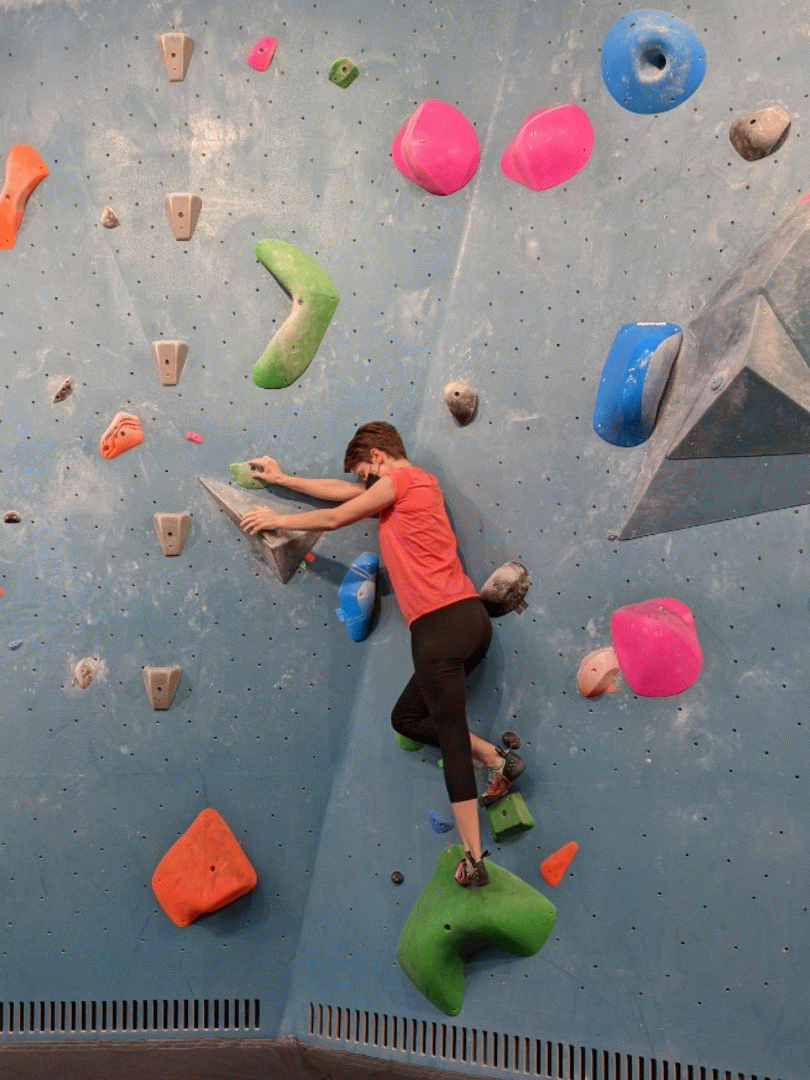
I’ve gone down a YouTube rabbit hole of bouldering videos to improve my technique. Like many sports, climbing is much more about legs, core, and technique than arm strength. While a certain baseline strength is required to grab certain holds, it is much more efficient to use larger leg muscles to push up the wall and to use arms and hands for balance and steering. Weight distribution, flexibility, foot placement, and finding the right “beta” (path up the wall) are critical skills to develop. The mental problem-solving involved in climbing makes it a well-rounded and engaging sport, compared to running, which I could never stick with. It’s addictive and keeps me coming back every session.
I really appreciate that strength, height, or gender doesn’t directly correlate to success in climbing. Sure, there are times when being able to pull myself up by the arms would be very handy, or having an extra inch of reach could help, but there are ways to accomplish the same climbs using other techniques. Sometimes, strength and height are detrimental, as a climb has holds that crunch up the body or can’t be accomplished by grabbing on hard without losing one’s balance. It means that I can climb with people of all different heights and strength levels. We can learn from each other by seeing how other people try to climb the same problem. Two people can climb the same problem in entirely different ways, and both are valid! It feels like the great equalizer of sports since sheer physical strength doesn’t directly correlate success.
Onward and Upward
Last week, I was struggling with a green overhang problem and a green slab problem. This week, I sent them both. My body is getting so much stronger every time and it’s so amazing to see this consistent improvement. I know that at some point I will plateau and need to focus more on specific techniques and strength training (ahem, grip strength, ahem) before reaching the next level, but for now I’m making so much progress just by climbing regularly, stretching for recovery, and doing yoga to improve flexibility and stability. My biceps are getting shredded and I have calluses forming on my hands.
When I started, I could barely make the first move on this green overhang problem | Images taken by Lucy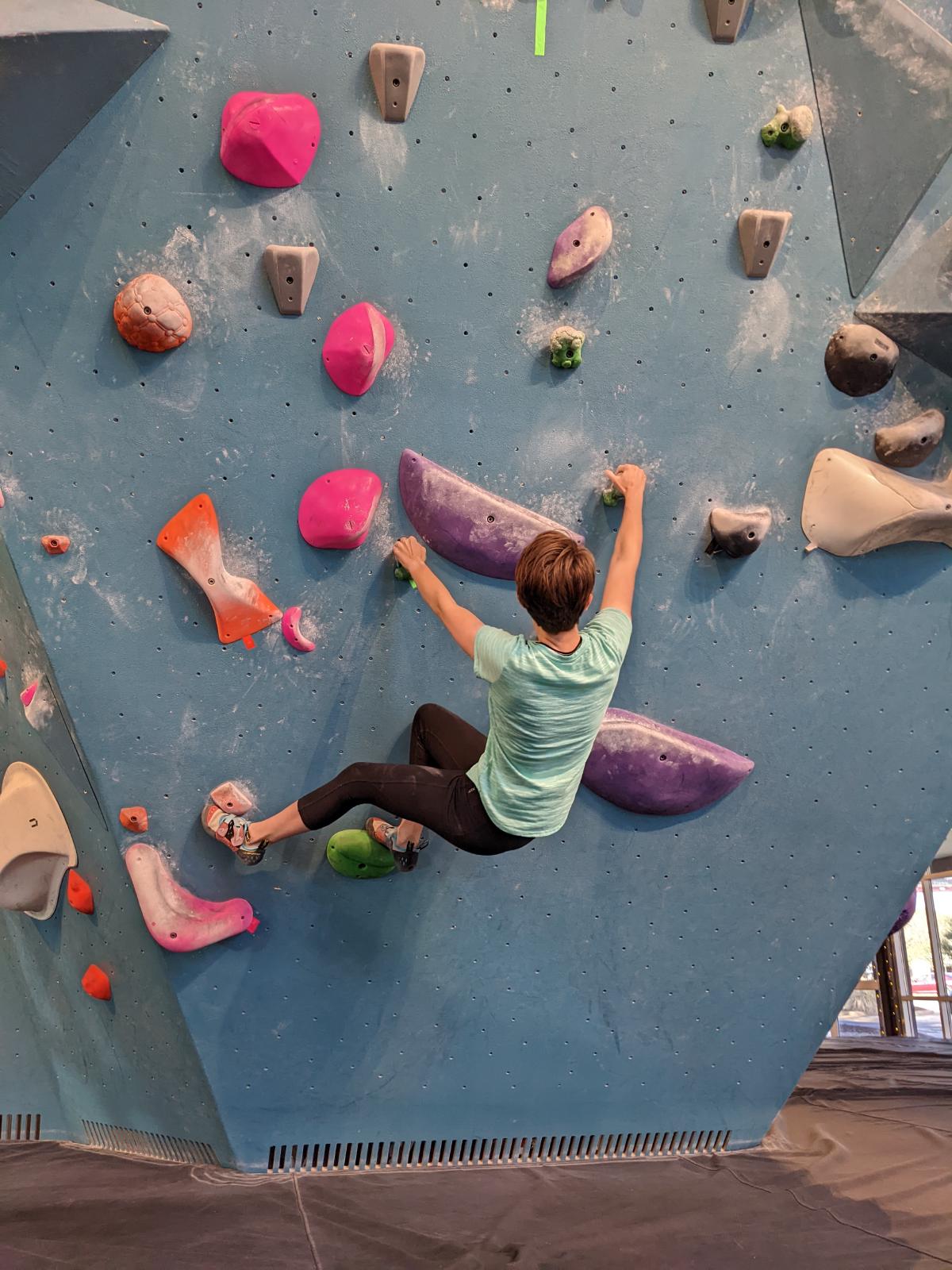
If there is something that you’ve always wanted to try growing up but never really had the chance, I highly recommend giving it a good shot. Maybe you always wanted to learn to draw or to bake or to perform in a musical. Life is too short to not give it an honest go. I feel so much happier now that I have finally dedicated this time to climbing. It feels like something has slotted into place in my mind. I feel at peace knowing that this is a hobby I can keep up for many years and never get bored.
There is also a wonderful gym all around us (aka the great outdoors), which I look forward to exploring someday. What’s better than spending a sunny day outside climbing some rocks with friends in nature? It’s truly a great way to experience a place and enjoy being outside. In general, climbers are incredibly welcoming of newcomers since they were all beginners once too. I can’t wait to explore this community more.

